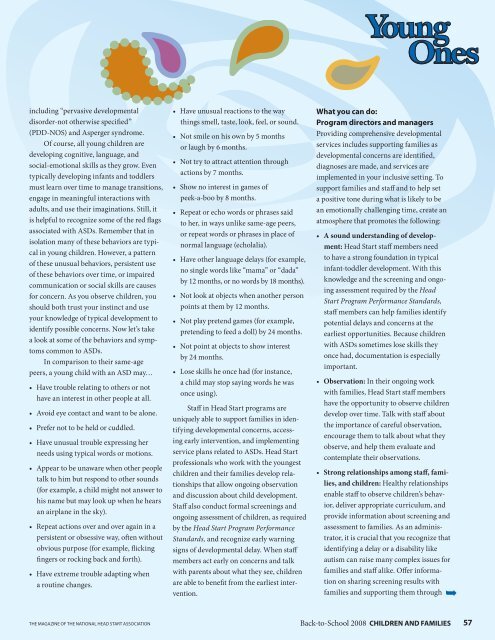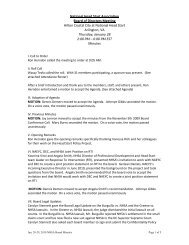New! - National Head Start Association
New! - National Head Start Association
New! - National Head Start Association
Create successful ePaper yourself
Turn your PDF publications into a flip-book with our unique Google optimized e-Paper software.
including “pervasive developmental<br />
disorder-not otherwise speci ed”<br />
(PDD-NOS) and Asperger syndrome.<br />
Of course, all young children are<br />
developing cognitive, language, and<br />
social-emotional skills as they grow. Even<br />
typically developing infants and toddlers<br />
must learn over time to manage transitions,<br />
engage in meaningful interactions with<br />
adults, and use their imaginations. Still, it<br />
is helpful to recognize some of the red ags<br />
associated with ASDs. Remember that in<br />
isolation many of these behaviors are typical<br />
in young children. However, a pattern<br />
of these unusual behaviors, persistent use<br />
of these behaviors over time, or impaired<br />
communication or social skills are causes<br />
for concern. As you observe children, you<br />
should both trust your instinct and use<br />
your knowledge of typical development to<br />
identify possible concerns. Now let’s take<br />
a look at some of the behaviors and symptoms<br />
common to ASDs.<br />
In comparison to their same-age<br />
peers, a young child with an ASD may…<br />
• Have trouble relating to others or not<br />
have an interest in other people at all.<br />
• Avoid eye contact and want to be alone.<br />
• Prefer not to be held or cuddled.<br />
• Have unusual trouble expressing her<br />
needs using typical words or motions.<br />
• Appear to be unaware when other people<br />
talk to him but respond to other sounds<br />
(for example, a child might not answer to<br />
his name but may look up when he hears<br />
an airplane in the sky).<br />
• Repeat actions over and over again in a<br />
persistent or obsessive way, o en without<br />
obvious purpose (for example, icking<br />
ngers or rocking back and forth).<br />
• Have extreme trouble adapting when<br />
a routine changes.<br />
• Have unusual reactions to the way<br />
things smell, taste, look, feel, or sound.<br />
• Not smile on his own by 5 months<br />
or laugh by 6 months.<br />
• Not try to attract attention through<br />
actions by 7 months.<br />
• Show no interest in games of<br />
peek-a-boo by 8 months.<br />
• Repeat or echo words or phrases said<br />
to her, in ways unlike same-age peers,<br />
or repeat words or phrases in place of<br />
normal language (echolalia).<br />
• Have other language delays (for example,<br />
no single words like “mama” or “dada”<br />
by 12 months, or no words by 18 months).<br />
• Not look at objects when another person<br />
points at them by 12 months.<br />
• Not play pretend games (for example,<br />
pretending to feed a doll) by 24 months.<br />
• Not point at objects to show interest<br />
by 24 months.<br />
• Lose skills he once had (for instance,<br />
a child may stop saying words he was<br />
once using).<br />
Sta in <strong>Head</strong> <strong>Start</strong> programs are<br />
uniquely able to support families in identifying<br />
developmental concerns, accessing<br />
early intervention, and implementing<br />
service plans related to ASDs. <strong>Head</strong> <strong>Start</strong><br />
professionals who work with the youngest<br />
children and their families develop relationships<br />
that allow ongoing observation<br />
and discussion about child development.<br />
Sta also conduct formal screenings and<br />
ongoing assessment of children, as required<br />
by the <strong>Head</strong> <strong>Start</strong> Program Performance<br />
Standards, and recognize early warning<br />
signs of developmental delay. When sta<br />
members act early on concerns and talk<br />
with parents about what they see, children<br />
are able to bene t from the earliest intervention.<br />
Young<br />
Ones<br />
What you can do:<br />
Program directors and managers<br />
Providing comprehensive developmental<br />
services includes supporting families as<br />
developmental concerns are identi ed,<br />
diagnoses are made, and services are<br />
implemented in your inclusive setting. To<br />
support families and sta and to help set<br />
a positive tone during what is likely to be<br />
an emotionally challenging time, create an<br />
atmosphere that promotes the following:<br />
• A sound understanding of development:<br />
<strong>Head</strong> <strong>Start</strong> sta members need<br />
to have a strong foundation in typical<br />
infant-toddler development. With this<br />
knowledge and the screening and ongoing<br />
assessment required by the <strong>Head</strong><br />
<strong>Start</strong> Program Performance Standards,<br />
sta members can help families identify<br />
potential delays and concerns at the<br />
earliest opportunities. Because children<br />
with ASDs sometimes lose skills they<br />
once had, documentation is especially<br />
important.<br />
• Observation: In their ongoing work<br />
with families, <strong>Head</strong> <strong>Start</strong> sta members<br />
have the opportunity to observe children<br />
develop over time. Talk with sta about<br />
the importance of careful observation,<br />
encourage them to talk about what they<br />
observe, and help them evaluate and<br />
contemplate their observations.<br />
• Strong relationships among sta , families,<br />
and children: Healthy relationships<br />
enable sta to observe children’s behavior,<br />
deliver appropriate curriculum, and<br />
provide information about screening and<br />
assessment to families. As an administrator,<br />
it is crucial that you recognize that<br />
identifying a delay or a disability like<br />
autism can raise many complex issues for<br />
families and sta alike. O er information<br />
on sharing screening results with<br />
families and supporting them through<br />
THE MAGAZINE OF THE NATIONAL HEAD START ASSOCIATION Back-to-School 2008 CHILDREN AND FAMILIES 57




